Excerpts from Jim Conrad's
Naturalist Newsletter
from the April 23, 2017 Newsletter issued from Rancho Regenesis in the woods ±4kms west of Ek Balam Ruins; elevation ~40m (~130 ft), N20.876°, W88.170°; north-central Yucatán, MÉXICO
DUTCHMAN'S-PIPE FRUITS
It's always surprising to see how many butterfly species produce caterpillars that feed on the vine called Dutchman's-Pipe, genus Aristolochia of the Dutchman's-Pipe Family, the Aristolochiaceae. However, when I go looking for Dutchman's-Pipe, usually it's hard to find, and normally I don't find any. Even when present its twining vines are inconspicuous, despite the species' bizarre and beautiful flowers.
Nowadays at the end of the dry season when most woody plants have lost their leaves to cut down on water loss, Dutchman's-Pipe vines are leafless and flowerless, but many vines bear fruits that do catch our attention, often seen dangling from high and mid-level tree limbs. The fruit are as exotic-looking as the gaudy, saxophone-shaped flowers, looking like apple-sized Chinese lanterns, as shown below:
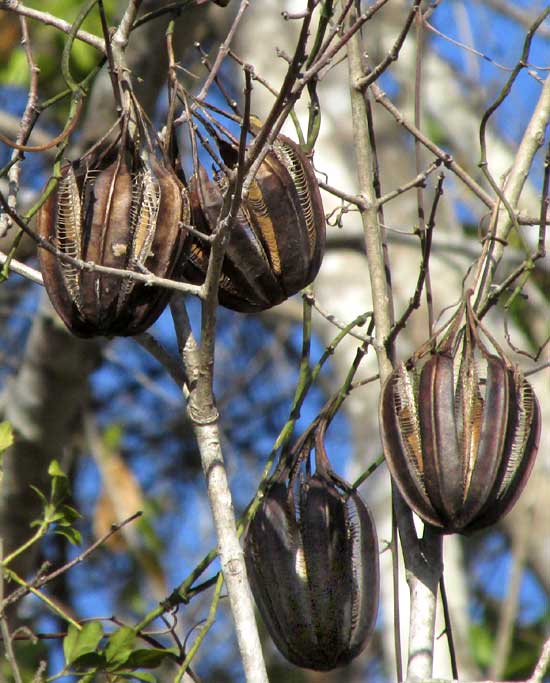
Three Aristolochia species are listed for the Yucatan, and of those three the species with fruit pods most looking like these is ARISTOLOCHIA MAXIMA, a species distributed from southern Mexico into Central America, and South America, plus it's been introduced into Florida. In fact, in the US, wildflower books call this the Florida Dutchman's-Pipe, but of course down here that name just won't do.
The fruits in the picture are almost or entirely identical to a Dutchman's-Pipe fruit we encountered in 2008, in Chiapas {see below}, when my friend Antonio brought some stem, leaf and fruit material to my door so I could make a tea from the stem and leaves to cure my upset stomach.
Antonio, who spoke Tzotzil, called the plant Guaco, and here in the Yucatan that's considered the Spanish name, so maybe our Chiapas plant also was Aristolochia maxima. Here in the Yucatan the Maya also regard the vine as medicinal,and, as in Chiapas, particularly good for upset stomach.
from the April 30, 2017 Newsletter issued from Rancho Regenesis in the woods ±4kms west of Ek Balam Ruins; elevation ~40m (~130 ft), N20.876°, W88.170°; north-central Yucatán, MÉXICO
DUTCHMAN'S-PIPE FRUIT WITH LEAVES
Last week we looked at a Dutchman's-Pipe vine's fruits, shown above. At that time we reckoned the name of the vine to be Aristolochia maxima, but it was a little awkward making the identification based only on fruits. This week another vine was found bearing both fruits and leaves, shown below:
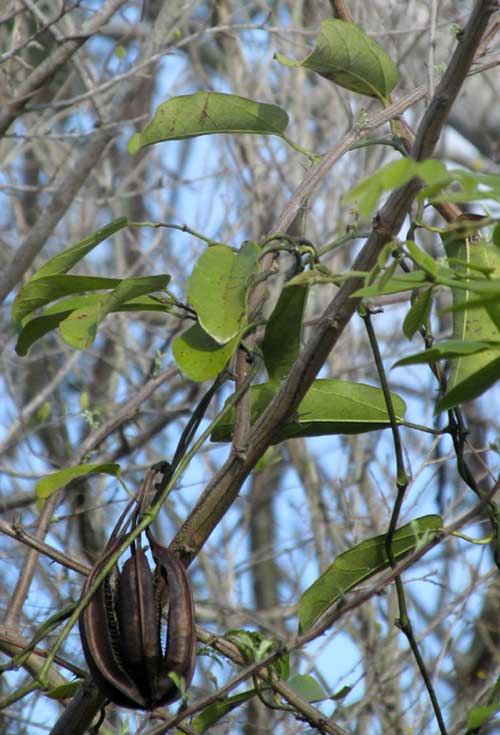
Now with greater confidence I can call our local Dutchman's Pipes Aristolochia maxima.
from the February 18, 2008 Newsletter written in the community of 28 de Junio, in the Central Valley, 8 kms east of Pujiltic, Chiapas, MEXICO
DUTCHMAN'S PIPE FOR UPSET STOMACH
After three days of drinking the piped spring-water I developed an upset stomach, a mild diarrhea and a complete loss of appetite. It wasn't like any reaction I'd ever experienced to water or food contamination so I'm still unsure whether it was the water that caused my problems. A flu-like thing has been going around in the highlands so maybe I had that.
When my friend Antonio heard that my stomach was upset, about half an hour later he thumped on my door and there he stood holding some goodies, as shown below:
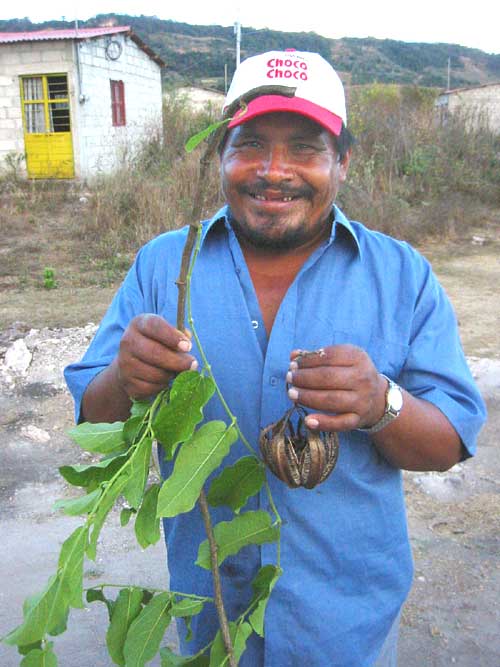
On the left is a semi-woody vine issuing new, green, leafy stems. On the right is the vine's remarkable fruit. It took me awhile to realize that this plant is what Northerners often call Dutchmans-Pipe, sometimes also called Birthwort or Pelican-Flower. It's a member of the genus ARISTOLOCHIA, of the Dutchmans-Pipe or Birthwort Family, the Aristolochiaceae. Aristolochia flowers are eerily beautiful things, often purple to lurid greenish-yellow, frequently carrion-scented, and configured into a U-shaped tube flaring at the end, like a saxophone or Dutchman's pipe.
Antonio called the plant Guaco and my Plantas Medicinales de México dedicates more pages to Guaco than almost anything else. Traditionally the plant seems to have been used mainly for snakebite, but also it's famous for calming upset stomachs.
"Break the stem into sections about finger length, add a few green leaves, boil them in about a quart of water, drink the tea, and you'll feel better," Antonio said, and at dusk I built a campfire and did just that.
The next morning my diarrhea was gone, I felt OK, but still had no appetite. On the fourth day I was eating normally. I really can't say if the treatment helped or whether the sickness passed on its own, but the next time I get an upset stomach I'm going looking for Guaco.
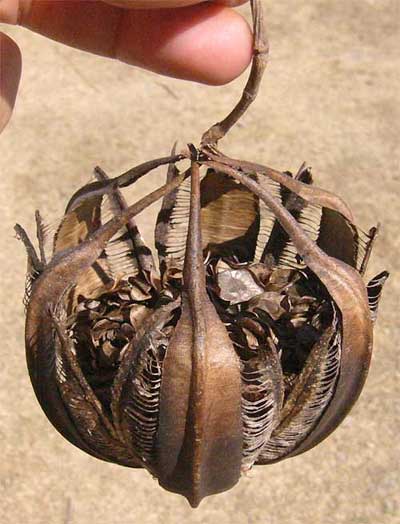
Above is a closer look at the Aristolochia fruit. Typical of other Aristolochia fruits, this fruit started out as an inferior ovary with six cells. The ovary matured into an oblong-cylindric capsule holding rows of seeds stacked atop one another. As the mature capsule dried it expanded, the walls of the six cells transformed into comblike fringes along the solid outer parts, and the stacks of seeds inside the fruit tumbled into a loose pile. The final creation is like an intricate Chinese lantern half filled with loose seeds, each seed bearing thin, paper-like wings.
The other day I saw such a fruit high in a Black Sopote tree. A brilliantly orange, black and white Altamira Oriole flew to the fruit, dipped his beak inside it and rummaged among the loose seeds. What a pretty sight!
The Aristolochia Family is closely related to the Buckwheat Family. Botanists among you may recognize the similarity of the winged seeds inside the Aristolochia capsule with, say, those of the Buckwheat Family's sorrel or dock, genus Rumex.
from the January 18, 2019 Newsletter issued from Rancho Regenesis in the woods ±4kms west of Ek Balam Ruins; elevation ~40m (~130 ft), N20.876°, W88.170°; north-central Yucatán, MÉXICO
DUTCHMAN'S-PIPE'S IMMATURE FRUITS
Once again the vine's flowering season has passed without my spotting the flowers, but at least now I can show you what the dangling immature fruits look like, below:
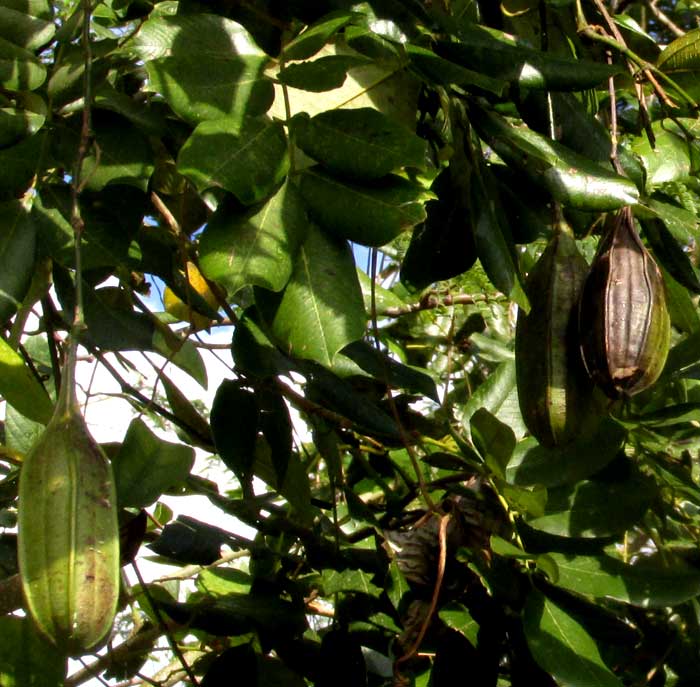
Three Dutchman's-Pipe species are listed for the Yucatan Peninsula, but the fruits of the other two species are a bit different, especially in lacking the comb-like "teeth" along the major sections' margins. Fortunately for ID purposes, this week's vine bore at least one mature fruit with the teeth typical of Aristolochia maxima, shown below almost hidden high in the host tree:
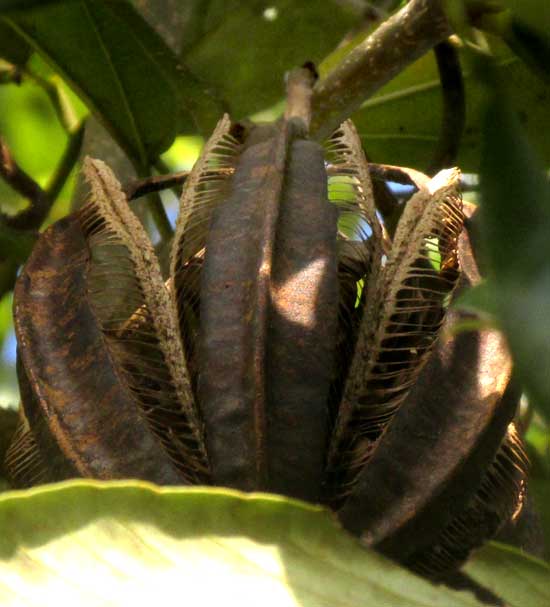
On our Aristolochia maxima page the vine's pinnately compound leaves have lost most of their leaflets. A leaf with all its leaflets is shown below:
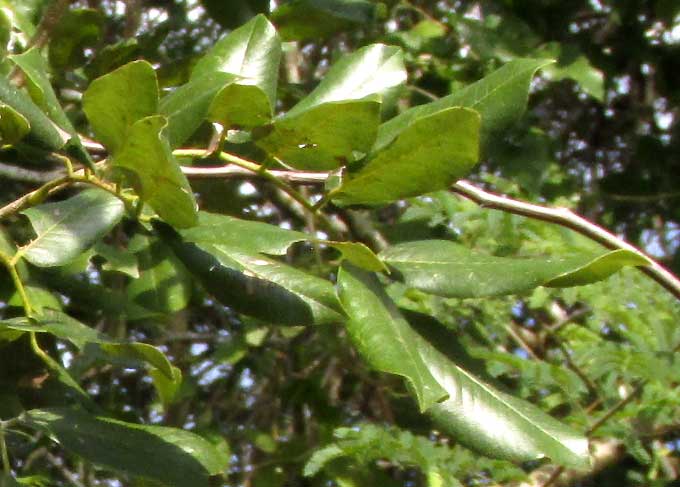
Aristolochia maxima is distributed from southern Mexico south throughout Central America into northern South America